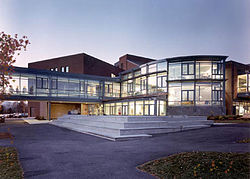Johnson State College
Early on Johnson embraced the ideas of learning from experience, and the role of the student in directing some part of their curriculum.
A commitment to educating the whole student in an interdisciplinary manner, begun in the 1920s and 1930s, set in place a history of bringing visiting poets, playwrights, politicians, and artists to the college.
Recent visitors to the campus include Japanese and Cuban drummers, New Orleans jazz musicians, and Buddhist monks who installed an environmental art work at Lower Pond.
Johnson State College teams participated as a member of the National Collegiate Athletic Association's Division III.
Men's sports included basketball, cross country, golf, lacrosse, soccer, tennis, track & field, and volleyball; while women's sports included basketball, cross country, soccer, softball, tennis, track & field, and volleyball.
The student is engaged not solely on her or his degree program, but as an adult citizen with emphasis on their place in, and contribution to, their society, nation, and world.
Ninety-one percent of the college's faculty hold a Ph.D. or equivalent doctorate level terminal degree in their area of instruction.
The striking late modernist building, whose sculptural roofline echoes the contours of the Sterling Mountain Range–its backdrop to the south, is the work of architect Robert Burley.
The LLC houses the largest collections of fine arts publications in Vermont and is a designated National Archives and Records Administration repository.
John Dewey Hall on the south side of the quadrangle was built in 1963 in the International Style; to house the college's library.
The Digital Imaging Laboratory (DIL) is also located here with state-of-the-art oversized high-resolution laser CMYK and Inkjet printers.
Students in their junior and senior years, especially those presenting thesis level work exhibit in the Julian Scott Memorial Gallery at the Dibden Center for the Arts.
Named for the scientist-artist, Wilson Bentley (1865–1931) who first photographed snowflakes in the nineteenth century in nearby Jericho, Vermont.
Bentley brought an objective scientific eye to the examination of snow and ice crystals via hugely magnified images called photomicrographs.
A 200-seat lecture hall with digital projection facilities, an interactive television studio, and laboratories for biology, chemistry, physical sciences, cartography, and geographic information systems.
Bentley Hall also houses a state-of-the-art interactive multimedia computer laboratory and is a designated National Science Foundation research facility.
The Babcock Nature Preserve, located ten miles from Johnson in Eden, Vermont is a 1,000 acre (4 km2) tract of forest land owned and maintained by the college for scientific and educational study.




